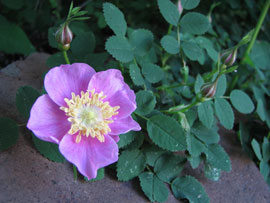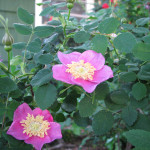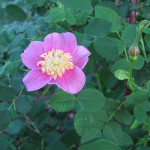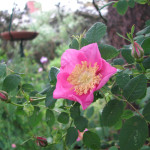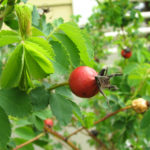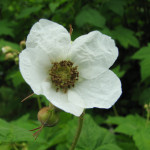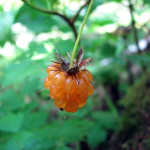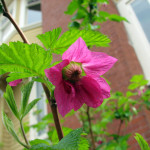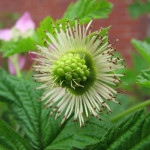Rosa nutkana var. nutkana
The Nootka rose is an attractive shrub growing up to 9′ high. The straight, erect stems are usually green, but occasionally may be reddish. The prickles are larger and thicker than those of the other native rose species.
The leaves are alternate on the stems and pinnately compound with 5-7 leaflets, dark green above, paler and slightly hairy below. The leaflets are elliptic or ovate in shape with serrate margins, and range from 1-7 cm long and 0.7-4.5 cm wide.
The sweet-scented, pink flowers are usually solitary, occasionally growing in groups of 2 or 3. They are large and showy, ranging from 5-8 cm across. Individual petals are 2.5-4 cm long, and 5 petals are the norm for the flowers. The rose hips are spherical, orange-red and large, ranging from 1-2 cm wide.
Uses
Wild rose is spindly and tends to form loose thickets, which in large spaces makes it useful as a hedgerow or as a wildlife-friendly ornamental. The leaves and fruits are important food sources for herbivores and upland game birds, and rose thickets provide excellent nesting and escape habitat for songbirds. The plant also has many traditional uses in Native American culture. Rose hips can be made into jam, tea, and used as flavoring, and the leaves have a variety of medicinal uses. Dried flower petals are used for scents and potpourri.
Habitat
Nootka rose may be found in open upland woods or in open shrub wetlands. In areas where both Rosa nutkana and Rosa woodsii occur, the former may be found at higher elevations and often in woods.
- Light Requirements: Full Sun, Part Shade
- Water Requirements: Dry, Moist, Seasonally Wet
- Ease of Growing: Easy to grow
- Growth Rate: Moderate
- Spreads: Yes
- Wildlife Support: Pollinators, Pest-eating Insects, Birds or Mammals
- Fire-resistant: Yes
- Edible: Yes
- Mature Height: 6-10ft
- Mature Width:3-4ft
Thimbleberry

Rubus parviflorus
Thimbleberry (Rubus parviflorusis) is a dense, spreading deciduous shrub that grows 4-6 feet tall and wide. It is a friendly plant with large, soft, fuzzy leaves and no thorns or prickles. The white flowers have five petals and a pale yellow center. The delicious fruits are like large, soft, velvety raspberries.
Thimbleberries are used by many kinds of wildlife year round. They are important sources of nectar, nest material, and winter shelter for native bees. Yellow-banded sphinx moths eat the leaves when young, and the berries are eaten by dozens of species.
These thicket-forming plants typically grow along roadsides, railroad tracks, and in forest clearings, commonly appearing soon after clear cuts and forest fire areas. In urban areas, thimbleberries can form a natural hedge at the back of the garden or provide cover on sunny, dry hillsides.
- Light Requirements: Full Sun, Part Shade, Full Shade
- Water Requirements: Dry, Moist
- Ease of Growing: Easy to grow
- Growth Rate: Moderate
- Spreads: Yes
- Wildlife Support: Pollinators, Hummingbirds, Pest-eating Insects, Birds or Mammals
- Fire-resistant: No
- Edible: Yes
- Mature Height: 4-6ft
- Mature Width:3-6ft
Salmonberry

Rubus spectabilis
Salmonberry (Rubus spectabilis) is an upright shrub growing to 10 feet tall, with a unique vase-like shape and prickly stems. The purple-magenta flowers bloom April through June. The orange-red, raspberry-like fruit matures in late summer to early autumn.
Salmonberry is a great wildlife plant for a large yard or garden; the open flowers attract bumblebees and hummingbirds while the fruit is a treat for thrushes, tanagers, finches, and wrens. Native bees also use it extensively for nesting material and winter shelter.
Salmonberries grow in moist forest openings and stream margins, so it does best in full sun to part shade and moist to wet soils. They often form large thickets, and thrive in the open spaces under stands of red alder.
- Light Requirements: Full Sun, Part Shade, Full Shade
- Water Requirements: Moist, Seasonally Wet
- Ease of Growing: Easy to grow
- Growth Rate: Moderate
- Spreads: Yes
- Wildlife Support: Pollinators, Hummingbirds, Pest-eating Insects, Birds or Mammals
- Fire-resistant: No
- Edible: Yes
- Mature Height: 4-10ft
- Mature Width:4-10ft

